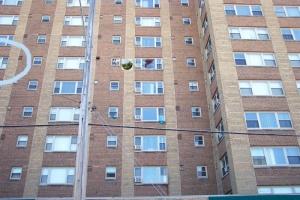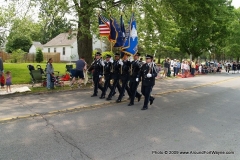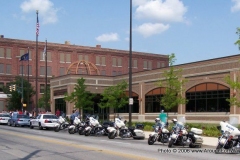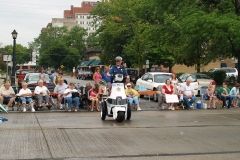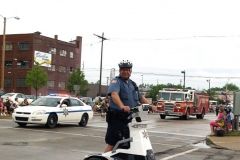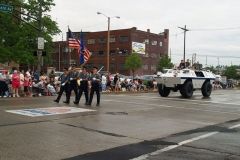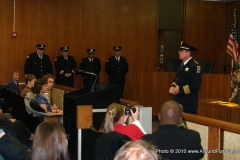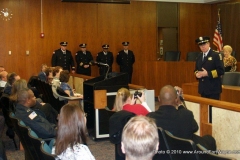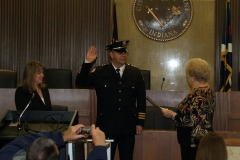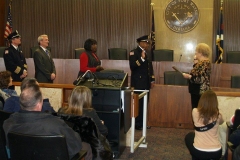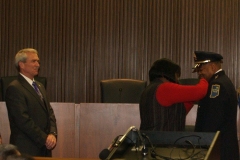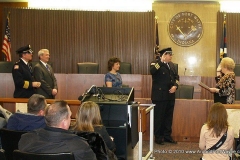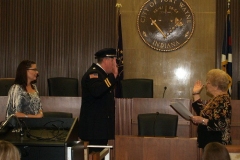After the Escobedo shooting: The window circled in blue is my apartment’s bedroom.
The smaller window on the right and bigger picture window were Escobedo’s bathroom
and bedroom windows. Â The larger broken window was his living room.
The Journal Gazette recently, April 10th to be exact, had an editorial piece about the 2005 Rudy Escobedo police-action shooting.
Those who know me personally, know that I lived in the apartment on the other side of the wall where Rudy was shot and killed. Â I blogged about it briefly last August.
The JG article sites a recent federal appeals court ruling in the lawsuit brought about by Rudy’s family against the City titled, “Disturbing details about ’05 shooting“.
The omission I refer to, which may not have been covered in the lawsuit, but which was certainly part of the “mishandling” that day by police was the fact that the entire floor had not been cleared.  My bedroom, which was where I’d been sleeping that morning, up until about 20 minutes before the police entered his apartment, was on the other side of the closet where they shot him.  Only metal studs and dry wall separated me from the action.  It was probably the first round of tear gas that woke me up that morning.  I’d heard loud noises all that morning, but loud noises weren’t something unusual in that building.  My neighbor’s door – all apartment doors were old, warped, metal doors with metal frames – would stick and he usually had to give it an extra shove and bang to get it to shut properly.  So the noises weren’t all that unusual.
So a logical question you might ask, “How do you know the police didn’t try to wake you?” Â I’d asked my neighbor’s mom, who’d been in his apartment at the same time if the police had tried to get her out. Â “No,” was the response. Â I asked, “Did they knock on my door?” Â Again, “No.” Â My phone was directly connected to a call box in the lobby. Â A phone call would have definitely reached me – but no phone calls that morning.
A lot of memories haunt me from that morning and the immediate days and weeks after, for instance, the memory of walking down seven flights of stairs in tear gas.
At first there weren’t a lot of details available, so slowly the picture came together. Â I remember being grateful that the police were there to save me from a neighbor hyped up on cocaine. That gratitude was short lived, however, when it became apparent the situation had been going on for hours which should have allowed plenty of time to evacuate the floor and surrounding units.
It became even harder when about a week later, I was able to tour one of the apartments directly above Escobedo’s whose floor plan was the same as his. Â It was at that chilling moment I learned the wall separating our bedrooms was only metal studs and drywall. Â Instantly, my thoughts turned to the fact that I’d been sleeping mere feet from the happenings next door… Â The chill turning to anger at my “saviors” not saving me, but rather leaving me in a rather perilous predicament. Â Thoughts of, “What if he’d shot through that wall? Â I could have been injured or even killed and no one would have known until everything was said and done.” Â (Those of you who know me, I think will agree that I’m not one given over easily to dramatics.)
And now, almost five years later, even more chilling details about the handling of the situation. Â I’m disappointed that the JG didn’t fill in some of the blanks obviously still unanswered by this ruling.
I have swayed on this issue many times in five years. Â At times, coming down on the side of the police, at other times, Rudy’s. Â I wrote last August:
[…] I myself vacillated back and forth between rage and praise for the police department over the handling of the Escobedo shooting. I’ve since come to the conclusion that there was one person in control of how it was going to end. If he had put the gun down and given himself up, it would have had a completely different outcome. He did not and he forced the police action that day. You can say that he was irrational because of the drugs and therefore the police should have protected him. You can say the police response was massive. But don’t I, as a purely innocent bystander, have the right to be protected? Isn’t that their job, to protect us against the dangerous and irrational people and circumstances that occur? We can’t have it both ways.
Has this recent ruling affected my thinking?  Absolutely.  While perhaps not innocent, at this point in my thinking, my impression is that Escobedo was more incapacitated by police action than cocaine – and that’s what really makes this situation tragic and one which I hope I am not to be acquainted with first-hand ever again in my lifetime.
From the editorial:
The court ruling raises several questions about police conduct in the Escobedo shooting:
- The police Crisis Response Team did not follow its own protocol for monitoring the telephone negotiations with Escobedo. The commander should have been listening directly but wasn’t, forcing him to rely on secondhand information.
- When police established the second telephone link, they failed to give Escobedo the new phone number. After tear gas was shot into his apartment, Escobedo tried calling the police number he had been given previously five times, but no one answered.
- Escobedo had committed no crime when police decided to hurl excessive tear gas into his downtown apartment.
- About an hour before tear gas was fired, the negotiator believed Escobedo was removing some of the items he used to block his door, a positive sign. The negotiator “assumed (wrongly) that this information was communicated to the commanders,” the court ruling states.
- One top official wrongly believed Escobedo had made threats. No one told the police scene commander that Escobedo specifically said, “I’m not going to hurt anybody.”
- Police said they had decided to move in by 8:30 a.m. partly because traffic would pick up near Escobedo’s apartment. An expert in police practices testified that Escobedo did not pose a threat and that traffic could have been detoured easily.
- At 8:28 a.m., Escobedo told the negotiator he was going to come out of the apartment and bring his gun.
- Police fired tear gas into the apartment at 8:33 a.m. and again about 10 minutes later. The levels were 12 times what was necessary, an amount that “was clearly and obviously excessive,” the police expert testified – so high that the police negotiator had to leave his position outside the apartment. When entering, police fired even more tear gas.
- Police fired “flash bang” grenades at Escobedo, including one that exploded just a few feet from his head, “certainly rendering him both blind and deaf at the time he was shot,” according to the court decision. Escobedo may not have seen officers or heard them order him to put down his gun before they shot and killed him.
- The use of tear gas was clearly unreasonable under existing law at the time of the Escobedo shooting, the court wrote in ruling the police conduct was an obvious constitutional violation.

